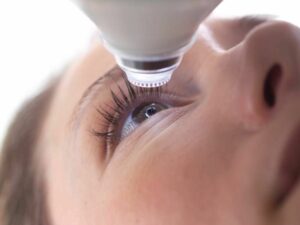With the advent of technology, we have seen significant strides in this field, leading to even more effective and accurate procedures. In this blog post, we delve into two such advancements – Femto LASIK and Contoura Vision, exploring their unique characteristics, how they work, their benefits, and considerations to keep in mind when opting for these procedures. Whether you’re considering a vision correction procedure or simply seeking knowledge, this comprehensive overview is for you.
Contents
What Is Femto LASIK?
 Femto LASIK, short for Femtosecond Laser-Assisted in Situ Keratomileusis, is an advanced form of the LASIK procedure that utilizes two types of laser technology for vision correction. The term “Femto” originates from the femtosecond laser used in the procedure. It operates at ultra-high speeds to create a precise and minimally invasive corneal flap. This is in contrast to traditional LASIK surgery, where a mechanical device with a blade (a microkeratome) is used to create this flap.
Femto LASIK, short for Femtosecond Laser-Assisted in Situ Keratomileusis, is an advanced form of the LASIK procedure that utilizes two types of laser technology for vision correction. The term “Femto” originates from the femtosecond laser used in the procedure. It operates at ultra-high speeds to create a precise and minimally invasive corneal flap. This is in contrast to traditional LASIK surgery, where a mechanical device with a blade (a microkeratome) is used to create this flap.
The Femto LASIK procedure starts with the use of the femtosecond laser to make a thin, circular flap in the cornea – the transparent front part of the eye. This flap is then folded back to expose the underlying cornea. A second laser, an excimer laser, is then used to reshape the corneal tissue, correcting the refractive errors that cause myopia (nearsightedness), hyperopia (farsightedness), and astigmatism. After the cornea has been reshaped, the flap is repositioned and naturally adheres back to the eye, without the need for stitches.
What Is Contoura Vision?
Contoura Vision, also known as topography-guided LASIK, is a highly advanced form of LASIK eye surgery. It employs topographical mapping to achieve highly personalized vision correction. The technology at the core of this procedure is able to measure and map the unique irregularities and contours of the individual’s cornea with an unprecedented level of precision.
These measurements are then used to guide the laser in reshaping the cornea. And ensuring an extremely individualized correction of the visual imperfections specific to each patient. The procedure begins with a detailed mapping of the cornea’s surface using a special device. This device creates a topographic map that illustrates the minute hills and valleys on the corneal surface, revealing irregularities that might not be detected by traditional methods.





mexico pharmacies prescription drugs
https://cmqpharma.online/# buying prescription drugs in mexico online
mexican online pharmacies prescription drugs
medication from mexico pharmacy: cmq pharma – pharmacies in mexico that ship to usa
mexican rx online mexico pharmacy mexico pharmacy
https://indiapharmast.com/# Online medicine order
northwest canadian pharmacy: canadian online pharmacy – my canadian pharmacy
buying from online mexican pharmacy: buying from online mexican pharmacy – mexico pharmacies prescription drugs
buy medicines online in india indian pharmacy buy prescription drugs from india
safe reliable canadian pharmacy: my canadian pharmacy review – canadian pharmacy price checker
https://foruspharma.com/# mexican drugstore online
mexican mail order pharmacies: mexican online pharmacies prescription drugs – medication from mexico pharmacy
indian pharmacies safe indian pharmacy best india pharmacy
purple pharmacy mexico price list: purple pharmacy mexico price list – mexico drug stores pharmacies
https://canadapharmast.online/# canadian compounding pharmacy
п»їbest mexican online pharmacies: medicine in mexico pharmacies – buying from online mexican pharmacy
indian pharmacy best india pharmacy online shopping pharmacy india
safe reliable canadian pharmacy: legit canadian online pharmacy – canadian pharmacies online
antibiotics cipro: cipro 500mg best prices – antibiotics cipro
https://clomiddelivery.pro/# where to get generic clomid online
http://amoxildelivery.pro/# amoxicillin in india
paxlovid pharmacy: paxlovid for sale – paxlovid india
https://amoxildelivery.pro/# buy amoxicillin online cheap
https://paxloviddelivery.pro/# paxlovid buy
amoxicillin 500 mg brand name: amoxicillin 500 mg online – amoxicillin 825 mg
http://ciprodelivery.pro/# ciprofloxacin mail online
where can i get amoxicillin: 875 mg amoxicillin cost – amoxicillin buy no prescription
https://paxloviddelivery.pro/# buy paxlovid online
http://ciprodelivery.pro/# ciprofloxacin 500mg buy online
amoxicillin online without prescription: amoxicillin 800 mg price – amoxicillin 500mg buy online canada
https://paxloviddelivery.pro/# п»їpaxlovid
ciprofloxacin 500mg buy online: buy cipro without rx – ciprofloxacin 500 mg tablet price
http://clomiddelivery.pro/# how can i get generic clomid without insurance
buy cipro without rx: buy cipro online usa – ciprofloxacin order online